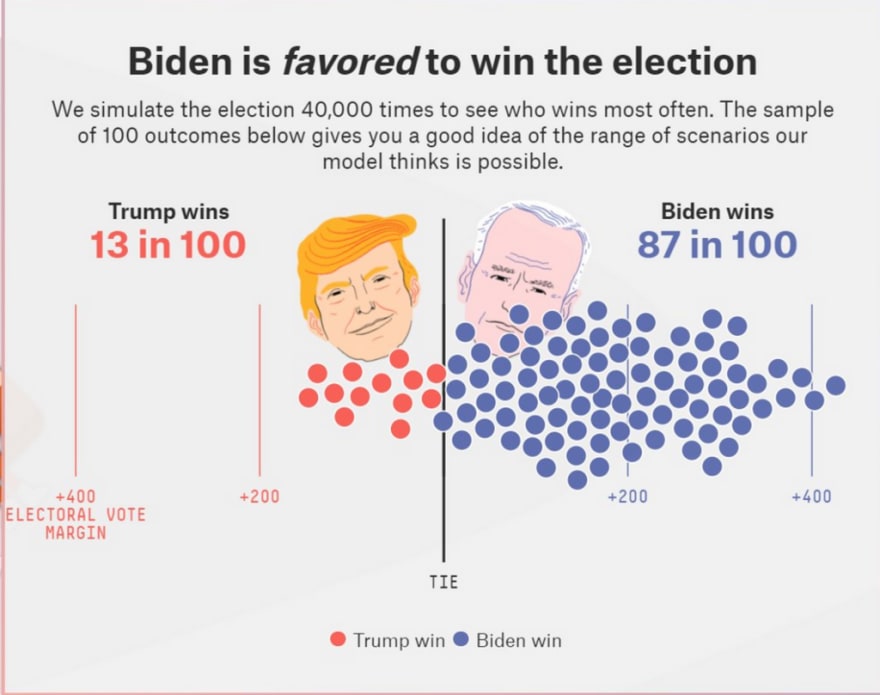The 2020 US presidential elections were riveting, and are still on-going at the time of writing this. In this post, we’ll dive into the significance of prediction markets, and how we leveraged them to trade the 2020 US presidential elections using an algorithmic arbitrage strategy.
Disclaimer:
- The above reflect the views of the investor and should NOT be construed as investment advice, financial advice or legal advice.
- This information is purely educational and is NOT meant to be taken as a recommendation to buy or sell any product or service. Please do your own research before making any decisions.
One of the standout features of this election (apart from Trump’s election fraud Hail Mary) was the presence of both expert predictions and liquid prediction markets.
Why is this important? First of all, this enabled market participants to “put their money where their mouth is” and trade on their election views. More importantly, this enabled the first widely followed battle between experts and markets.
In the weeks leading up to the election, polls and statistical models (FiveThirtyEight) were indicating a 15% chance of a Trump re-election, economic data models (The Economist) had him lower at 10%, and prediction markets (FTX, Betfair) had Trump higher at 35–40%.
Prediction/ betting markets represent the mean estimate of all of the market participants that placed monetary bets on their views. The bullish case for prediction markets stems from the incredible power of collective intelligence (CI), or “wisdom of the crowds” — the argument that the mean estimate of a sufficiently large population will be more accurate than any one individual’s. However, prediction markets are still in their infancy stage, with limited liquidity and restricted access, especially for large institutional investors. In addition, human biases such as confirmation bias, loss aversion, anchoring bias etc. can limit their accuracy.
Collective intelligence is shared or group intelligence that emerges from the collaboration, collective efforts, and competition of many individuals and appears in consensus decision making_ — Wikipedia_
Prediction Markets
There are three main types of prediction markets:
- Betting Sites : Betfair, PredictIt, Polymarket
- Centralized Crypto Exchanges : FTX
- Decentralized Exchanges : Augur, Catnip
Of the above, FTX had the highest liquidity, a centralized limit order book, and API integrations, enabling high-frequency algo trading.

Trading Strategy
FTX is a centralized crypto derivatives exchange that supports derivatives, options, volatility products and leveraged tokens for all major cryptocurrencies.
There were two main election-related products that were tradable on FTX: TRUMPWIN and TRUMPLOSE. These are cryptocurrencies that will be redeemable on FTX for either $1 or $0 USD based on whether Trump wins the election or not.
To clarify: we will be following the original rules for the contract, and will not expire the contracts unless a candidate has reached a majority of the electoral college votes or every one of the selected publications has called the election. If neither of those happen, the contracts will settle to whoever is president in February — FTX
Ignoring fees and slippage, it can be easily shown that the following equation must always hold:
Our arbitrage strategy was straightforward:
The goal here was to buy every time the underlying package dipped below its $1 fair-value and sell whenever it rose above $1, as the package could always be redeemed for $1 post-election. This strategy, in theory, would earn ~ 2% each time capital was turned over.
Fees
It’s easy to adjust the above equations to account for fees. Let f be the fee in bps (1bp = 0.01%) that is charged by the exchange. On FTX, the standard fee is 7bps (0.07%) per trade. The equations above can be re-written to account for fees as follows:
We used a 1% buffer to account for any potential slippage and latency that could occur for each trade. The 1% was chosen somewhat arbitrarily, in theory, a backtest could be run testing different buy/sell entry levels to maximize ROIC. Given our rush to deploy, we did not conduct this analysis.
Implementation
Step 1 : Write a script to constantly scrape TRUMPWIN & TRUMPLOSE prices.
Step 2 : Check to see if the BUY condition is met. If so, buy 500 of each of the coins.
Step 3 : Check to see if the SELL condition is met. If so, and if we are already sufficiently long, sell 500 of each of the coins.
Step 4 : Manage risk with a script to constantly check that we’re fully hedged (i.e, that we own equal amounts of each of the coins). This may occur due to failed trades, code bugs, fund balance issues etc. If we were ever un-hedged, we would sell the unbalanced coin to remain delta neutral.
Conclusion
The actual markets were a roller-coaster. On election night (Tue, Nov 2), TRUMPWIN spiked up to a high of $0.80, before subsequently crashing to low of $0.10, where it has stayed for the time being.
Who emerged as the winner — the experts or prediction markets? It’s unclear.
The polls’ and experts’ initial call was clearly more accurate, as they were less bullish on Trump heading into election night. However, this is the incorrect metric to benchmark performance as information continued to flow in throughout the night, and markets/models adjusted real-time, increasing volatility in the expected probabilities.
In theory, backtests would have to be run for multiple elections across multiple geographies to determine whether models or markets are better predictors. Also, when evaluating the performance of collective intelligence, a key metric of success must be defined — is it the collective estimate at time t=0 pre-election night, or should we look at a weighted average of the predictions throughout election night as a more accurate indicator?
Overall, the 2020 elections proved that prediction markets are a force to be reckoned with. Expect to see liquidity and trade volumes increase exponentially over the next few years, alongside increased institutional adoption and regulatory oversight. In the meanwhile, prediction markets will continue to provide great discretional and market-neutral opportunities for traders and investors.
Also, Read
- The Best Crypto Trading Bots
- The Best Bitcoin Hardware wallet
- Crypto Copy Trading Platforms
- The Best Crypto Tax Software
- Best Crypto Trading Platforms
- Best Wallet for Uniswap
- Best Crypto Lending Platforms
- BlockFi vs Celsius vs Hodlnaut
- Ledger vs Trezor
- Deribit Review
- Bitsgap review — A Crypto Trading Bot That Makes Easy Money
- Quadency Review- A Crypto Trading Bot Made For Professionals
- 3commas Review | An Excellent Crypto Trading Bot
- 3Commas vs Cryptohopper
- The Idiots Guide to Margin Trading on Bitmex
- The Definitive Guide to Crypto Swing Trading
- Bitmex Advanced Margin Trading Guide
- Best Crypto APIs for Developers
- Crypto arbitrage guide: How to make money as a beginner
- Top Bitcoin Node Providers
- Best Crypto Charting Tool
- What are the best books to learn about Bitcoin?


















Top comments (0)